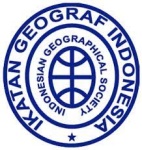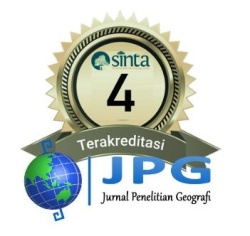Concept and Implementation of River Corridor to Ensure Environmental Sustainability of Citarum River, Indonesia
Abstract
The river corridor is literally a spatial passage that runs along the riverbanks. The corridor’s width varies significantly depending on its intended function, land-use designation, and the associated ecological and socio-economic benefits. In this study, the river corridor is defined in terms of its role in sustaining the river ecosystem, particularly as a water source and in preserving the integrity of its hydrological substance. The primary objective of this study is to examine both the conceptual framework and the practical implementation of river corridors in promoting environmental sustainability, using the Citarum River in Indonesia as a case study. The research area covers the entire stretch of the Citarum River, from its upstream origin (km 0) to the Citarum River, Indonesia. Key parameters analyzed include river morphology, land use patterns, geospatial technology applications in land-use monitoring, anthropogenic activities, and the physical condition of the river from the thalweg (deepest channel) extending 1 km laterally on both the left and right banks. Data were collected through an integrative approach combining literature review, field observation, photographic documentation, and in-depth interviews with local residents living along the river corridor over the past two years. The study identifies both conceptual insights and implementation cases of the river corridor framework within the study period. These findings lead to the formulation of evidence-based recommendations rooted in nature-based solutions aimed at ensuring the sustainable management and restoration of river ecosystems.
KEYWORDS: Citarum; Concept and Implementation; Environmental; River Corridor; Sustainability
Full Text:
PDFReferences
Agnew, D., & Fryirs, K. (2022). Identifying corridors of river recovery in coastal NSW Australia, for use in river management decision support and prioritisation systems. Plos one, 17(6), e0270285. https://doi.org/10.1371/journal.pone.0270285
Belote, R. T., Dietz, M. S., McRae, B. H., Theobald, D. M., McClure, M. L., Irwin, G. H., ... & Aplet, G. H. (2016). Identifying corridors among large protected areas in the United States. PLoS One, 11(4), e0154223. https://doi.org/10.1371/journal.pone.0154223
Bennett AF. Linkages in the landscape: The role of corridors and connectivity in wildlife conservation. Gland, Switzerland and Cambridge, UK: IUCN; 2003. xiv + 254 p.
Bouska, K. L., Houser, J. N., De Jager, N. R., Van Appledorn, M., & Rogala, J. T. (2019). Applying concepts of general resilience to large river ecosystems: a case study from the Upper Mississippi and Illinois rivers. Ecological Indicators, 101, 1094-1110. https://doi.org/10.1016/j.ecolind.2019.02.002
Brenna, A., Poletto, G., & Surian, N. (2024). Assessing the effectiveness of “River Morphodynamic Corridors” for flood hazard mapping. Geomorphology, 467, 109460. https://doi.org/10.1016/j.geomorph.2024.109460
Cohen-Shacham, E., Walters, G., Janzen, C., & Maginnis, S. (2016). Nature-based solutions to address global societal challenges. IUCN: Gland, Switzerland, 97(2016), 2036. http://dx.doi.org/10.2305/IUCN.CH.2016.13.en
Downes, N. K., Nam, N. D. G., Minh, N. A., Chi, V. D., Sang, L. T., Da Huynh, V., ... & Thanh, B. (2025). Climate risks and resilience in urbanizing areas of the Vietnamese Mekong Delta: Future action-orientated research needs. In The Mekong Delta environmental research guidebook (pp. 131-156). Elsevier. https://doi.org/10.1016/B978-0-443-23673-0.00006-4
Fontoura, L., D’agata, S., Gamoyo, M., Barneche, D. R., Luiz, O. J., Madin, E. M., ... & Maina, J. M. (2022). Protecting connectivity promotes successful biodiversity and fisheries conservation. Science, 375(6578), 336-340. https://doi.org/10.1126/science.abg4351
Fryirs, K. , & Brierley, G. (2022). Kumpulan unit geomorfik: Pendekatan blok penyusun untuk analisis dan interpretasi karakter, perilaku, kondisi, dan pemulihan sungai . Earth Surface Processes and Landforms , 47 ( 1 ), 92 – 108 . https://doi.org/10.1002/esp.5264
Garcia, X., Benages-Albert, M., Pavón, D., Ribas, A., Garcia-Aymerich, J., & Vall-Casas, P. (2017). Public participation GIS for assessing landscape values and improvement preferences in urban stream corridors. Applied Geography, 87, 184-196. https://doi.org/10.1016/j.apgeog.2017.08.009
Gartner, J. D., Hatch, C. E., & Vogel, E. (2019). The River Process Corridor: A Modular River Assessment Method Based on Process Units and Widely Available Data in the Northeast US.
Harvey, J. W., & Schmadel, N. M. (2021). The river corridor's evolving connectivity of lotic and lentic waters. Frontiers in Water, 2, 580727. https://doi.org/10.3389/frwa.2020.580727
Hilty J, Worboys GL, Keeley A, Woodley S, Lausche B, Locke H, et al. Guidelines for conserving connectivity through ecological networks and corridors. Gland, Switzerland: IUCN; 2020. Report No.: 1817–3713 Contract No.: 30.
Kaufman, Matthew H., Barnes, Morgan, Chen, Xingyuan, Forbes, Brieanne, Garayburu-Caruso, Vanessa A., Goldman, Amy E., Myers-Pigg, Allison, Powers-McCormack, Beck, Stegen, James C., & Scheibe, Timothy D. (2023). Geospatial Information, Metadata, and Maps for Global River Corridor Science Focus Area Sites (v4). https://doi.org/10.15485/1971251
Kirchner, J. W., Feng, X., and Neal, C. (2001). Catchment-scale advection and dispersion as a mechanism for fractal scaling in stream tracer concentrations. J. Hydrol. 254, 82–101. https://doi.org/10.1016/S0022-1694(01)00487-5
Knapp, J. L. A., Neal, C., Schlumpf, A., Neal, M., and Kirchner, J. W. (2019). New water fractions and transit time distributions at Plynlimon, Wales, estimated from stable water isotopes in precipitation and streamflow. Hydrol. Earth Syst. Sci. 23, 4367–4388. https://doi.org/10.5194/hess-23-4367-2019
Larsen, A., Larsen, J. R., & Lane, S. N. (2021). Dam builders and their works: Beaver influences on the structure and function of river corridor hydrology, geomorphology, biogeochemistry and ecosystems. Earth-Science Reviews, 218, 103623. https://doi.org/10.1016/j.earscirev.2021.103623
Lawler, J. J., Rinnan, D. S., Michalak, J. L., Withey, J. C., Randels, C. R., & Possingham, H. P. (2020). Planning for climate change through additions to a national protected area network: implications for cost and configuration. Philosophical Transactions of the Royal Society B, 375(1794), 20190117. https://doi.org/10.1098/rstb.2019.0117
Lindgren, G. A., and Destouni, G. (2004). Nitrogen loss rates in streams: scale-dependence and up-scaling methodology. Geophys. Res. Lett. 31:LI3501. https://doi.org/10.1029/2004GL019996
Lindgren, G. A., Destouni, G., and Miller, A. V. (2004). Solute transport through the integrated groundwater-stream system of a catchment. Water Resour. Res. 40:W03511. https://doi.org/10.1029/2003WR002765
Liu, C., Newell, G., White, M., & Bennett, A. F. (2018). Identifying wildlife corridors for the restoration of regional habitat connectivity: A multispecies approach and comparison of resistance surfaces. PloS one, 13(11), e0206071. https://doi.org/10.1371/journal.pone.0206071
Marshall, A., Wohl, E., Iskin, E., & Zeller, L. (2024). Interactions of logjams, channel dynamics, and geomorphic heterogeneity within a river corridor. Water Resources Research, 60(6), e2023WR036512. https://doi.org/10.1029/2023WR036512
Mazzorana, B., Nardini, A., Comiti, F., Vignoli, G., Cook, E., Ulloa, H., & Iroumé, A. (2018). Toward participatory decision-making in river corridor management: two case studies from the European Alps. Journal of Environmental Planning and Management, 61(7), 1250-1270. https://doi.org/10.1080/09640568.2017.1339593
Naiman, R. J., Decamps, H., and Pollock, M., 1993, The role of riparian corridors in maintaining regional biodiversity: Ecological applications, v. 3, no. 2, p. 209-212.
National Research Council, Division on Earth, Life Studies, Board on Environmental Studies, Water Science, Technology Board, ... & Strategies for Management. (2002). Riparian areas: functions and strategies for management. National Academies Press.
Nelson, A. D., Collins, V. D., Payne, J. S., & Abbe, T. B. (2024). Proactive river corridor definition: Recommendations for a process‐based width optimization approach illustrated in the context of the coastal Pacific Northwest. Wiley Interdisciplinary Reviews: Water, 11(3), e1711. https://doi.org/10.1002/wat2.1711
Palmer, M. A., Liu, J., Matthews, J. H., Mumba, M., & D'Odorico, P. (2015). Manage water in a green way. Science, 349(6248), 584-585. https://doi.org/10.1126/science.aac7778
Parsons, M., & Thoms, M. C. (2018). From academic to applied: Operationalising resilience in river systems. Geomorphology, 305, 242-251. https://doi.org/10.1016/j.geomorph.2017.08.040
Paul, B., Craig, G., Gary, K., Jason, B., Kit, M., John, P. D., & Anne, T. (2015). Conserving Biodiversity: Practical Guidance about Climate Change Adaptation Approaches in Support of Land-use Planning. https://doi.org/10.3375/043.035.0120
Pickett, S. T., and White, P. S., 1985, The ecology of natural disturbance and patch dynamics, Orlando, Fla., Academic Press
Poeppl, R. E., Keesstra, S. D., & Maroulis, J. (2017). A conceptual connectivity framework for understanding geomorphic change in human-impacted fluvial systems. Geomorphology, 277, 237-250. https://doi.org/10.1016/j.geomorph.2016.07.033
Qu, Y., Zeng, X., Luo, C., Zhang, H., Liu, Y., & Wang, J. (2024). Constructing wetland ecological corridor system based on hydrological connectivity with the goal of improving regional biodiversity. Journal of Environmental Management, 368, 122074. https://doi.org/10.1016/j.jenvman.2024.122074
Rohmat, D., Setiawan, I., Ismail, A., & Suhendro, S. (2024). Koridor sungai: antara budaya pemanfaatan lahan dan parameter kualitas air di DAS Citarum. Referensi Cendekia.
Ruangpan, L., Vojinovic, Z., Di Sabatino, S., Leo, L. S., Capobianco, V., Oen, A. M., ... & Lopez-Gunn, E. (2020). Nature-based solutions for hydro-meteorological risk reduction: a state-of-the-art review of the research area. Natural Hazards and Earth System Sciences, 20(1), 243-270. https://doi.org/10.5194/nhess-20-243-2020
Ryan, R. L. (1998). Local perceptions and values for a midwestern river corridor. Landscape and urban planning, 42(2-4), 225-237. https://doi.org/10.1016/S0169-2046(98)00089-9
Setiawan, I., Rohmat, D., Ismail, A., & Suhendro, S. (2024). Landuse culture and water quality (BOD, COD, DO) in the upper citarum river corridor. E3S Web of Conferences, 600. https://doi.org/10.1051/e3sconf/202460002009
Shi, L., Maruthaveeran, S., Yusof, M. J. M., & Dai, C. (2024). Exploring factors influencing recreational experiences of urban river corridors based on social media data. Applied Sciences, 14(10), 4086. https://doi.org/10.3390/app14104086
Shih, S. S., & Lee, C. Y. (2024). Eco-friendly dredging methods of changing fluvial landforms for enhancing hydraulic habitat quality and river corridor continuum. Science of The Total Environment, 936, 173439. https://doi.org/10.1016/j.scitotenv.2024.173439
Stegen, J., Chen, X., Myers-Pigg, A., Goldman, A. E., Fluet-Chouinard, E., Forbes, B. K., ... & Zheng, J. (2024, December). River corridor hydro-biogeochemistry from molecular to multi-basin scales. In AGU Fall Meeting Abstracts (Vol. 2024, No. 943, pp. H11T-0943).
Tomsett, C., & Leyland, J. (2019). Remote sensing of river corridors: A review of current trends and future directions. River Research and Applications, 35(7), 779-803. https://doi.org/10.1002/rra.3479
Turetcaia, A., Cardenas, M. B., Bennett, P., Li, B., Kaufman, M., Liu, X., ... & Stegen, J. (2021, December). Disentangling Channel and Hyporheic Zone Contributions to Dissolved Oxygen and CO2 Dynamics Responding to Particulate Organic Matter Perturbations in river Corridor Under Low Flow Conditions. In AGU Fall Meeting Abstracts (Vol. 2021, pp. H33E-03). https://ui.adsabs.harvard.edu/abs/2021AGUFM.H33E..03T
Ward, A. S. 2015. The evolution and state of interdisciplinary hyporheic research, Wiley Interdiscip. Rev. Water, 3, 83–103, https://doi.org/10.1002/wat2.1120
Ward, A. S., Packman, A., Bernal, S., Brekenfeld, N., Drummond, J., Graham, E., ... & Zarnetske, J. P. (2022). Advancing river corridor science beyond disciplinary boundaries with an inductive approach to catalyse hypothesis generation. Hydrological Processes, 36(4), e14540. https://doi.org/10.1002/hyp.14540
Ward, A. S., Wondzell, S. M., Schmadel, N. M., Herzog, S., Zarnetske, J. P., Baranov, V., ... & Wisnoski, N. I. (2019). Spatial and temporal variation in river corridor exchange across a 5th-order mountain stream network. Hydrology and Earth System Sciences, 23(12), 5199-5225. https://doi.org/10.5194/hess-23-5199-2019
Ward, A. S., Wymore, A. S., Wohl, E., & Harvey, J. W. (2023, December). The Evolution, State, and Future of River Corridor Critical Zone Science. In AGU Fall Meeting Abstracts (Vol. 2023, pp. H14D-01).
Wohl, E. (2021). An integrative conceptualization of floodplain storage. Reviews of Geophysics, 59(2), e2020RG000724. https://doi.org/10.1029/2020RG000724
Wohl, E., & Scamardo, J. (2022). Patterns of organic matter accumulation in dryland river corridors of the southwestern United States. Science of the Total Environment, 833, 155136. https://doi.org/10.1016/j.scitotenv.2022.155136
Wohl, E., Marshall, A. E., Scamardo, J., White, D., & Morrison, R. R. (2022). Biogeomorphic influences on river corridor resilience to wildfire disturbances in a mountain stream of the Southern Rockies, USA. Science of the Total Environment, 820, 153321. https://doi.org/10.1016/j.scitotenv.2022.153321
Wondzell, S. M. and Gooseff, M. N.: Geomorphic Controls on Hyporheic Exchange Across Scales: Watersheds to Particles, in: Treatise on Geomorphology, vol. 9, edited by: Schroder, J. and Wohl, E., 203–218, Academic Press, San Diego, CA, 2014.
Refbacks
- There are currently no refbacks.
INDEX JOURNAL

















